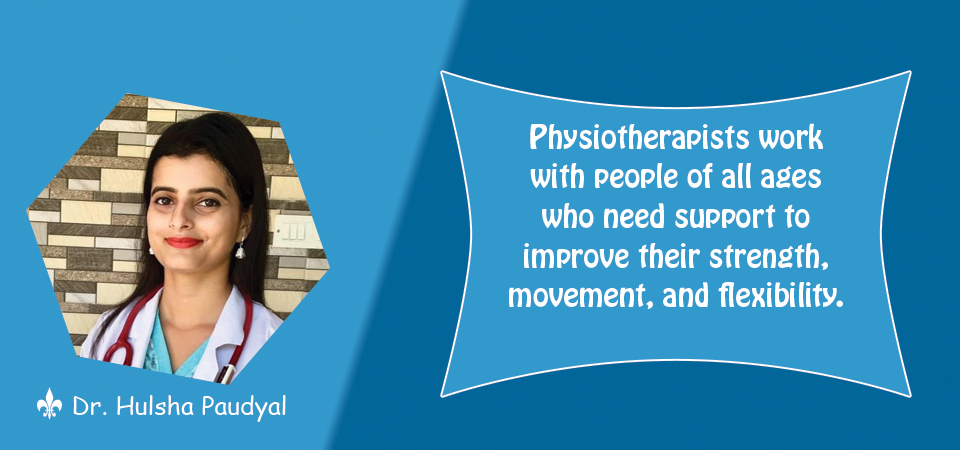Int’l Day Of Persons With Disabilities
Physiotherapy Boon For The Disabled

Dr. Hulsha Paudyal
Physical activity is required for good health. However, less than half of Nepal’s adults with serious difficulty in walking or climbing stairs (mobility disability) have been engaged in aerobic physical activity. For those who are active, walking is the most common physical activity. Yet, adults with disabilities report more environmental barriers to walking than those without disabilities. The International Classification of Functioning, Disability, and Health (ICF) framework prepared by the World Health Organisation (WHO) provides information on functioning and disability. It mentions standard language and a conceptual basis for the definition and measurement of health and disability.
In 20217, Nepal government has formulated Act relating to persons with disabilities which, classifies 10 types of disabilities. It can be a common misconception that physiotherapy is useful only to people who are recovering from an illness or injury. However, physiotherapy is ideal for supporting people with disabilities to participate in physical activities that they are interested in. Physiotherapists help people with disabilities maintain or improve their movement and mobility to maximise function and participation. Supporting people with disabilities to access sport, or recreation opportunities in the community such as team sports, PE lessons at school, local community classes, or gym programmes enhance their social participation, physical health, and wellbeing, thereby enabling them to achieve their goals.
Physical activity
All adults, with or without disabilities, get at least 150 minutes (2.5 hours) of aerobic physical activity per week. Activities can be broken down into smaller amounts, such as about 25 minutes a day every day. Muscle-strengthening activities, such as adapted yoga or working with resistance bands, provide additional health benefits. “Person with a disability” means a person who has long-term physical, mental, intellectual, or sensory disability or functional impairments or existing barriers that may hinder his or her full and effective participation in the social life on a par with other members of society.
Physiotherapists work with people of all ages who need support to improve their strength, movement, and flexibility. A physical therapist evaluates the patients and comes up with a treatment programme tailored to their needs. Emphasis is placed on patient education and training to ensure that the patient becomes independent as soon as possible. Treatment outcomes are evaluated as programme implementation progresses. Recommendations for self-management at home are made at the appropriate time.
There are several types of disabilities. Physical disability is a problem that arises in the operation of physical parts, use, and movement in a person. For example, it happens due to polio, lack of a physical organ, the effect of leprosy, muscular dystrophy, permanent problem associated with joints and backbone and reversal of clubfeet, among others. Disability-related to vision is the condition where there is no knowledge about an object's figure, shape, form, and colour in an individual due to the disability-related to hearing and combination of deafness and blindness. Disability-related to hearing develops when an individual cannot discriminate composition of the parts of hearing and voice, rise and fall of position, and level and quality of voice. Deaf-blind is a person without both hearing and vision or who has joint interaction of disabilities in two organs.
Likewise, the person with disability-related to voice and speech has difficulty in rise and fall of voice to speak. S/he lacks clear speech and repeats words and letters. Mental or psycho-social disability is the inability to behave in accordance with age and situation. Persons having this problem are slow in intellectual learning. In intellectual disability, a person faces problem in doing activity relative to the age. For instance, Down’s syndrome is intellectual disability. Person with disability associated with haemophilia suffers clotting of blood due to deflection in factors in blood resulting from genetic effect.
A person with autism has difficulty in communicating, understanding, and applying general social rules. S/he does not show normal behaviour corresponding to his/her age. They repeat the same activity, do not assimilate with others, or make reaction instantly. A person with multiple disabilities has two or more than two types of disabilities mentioned above. For example, person with cerebral palsy falls under this category.
Severe disabilities
Disability can also be classified based on severity. A person with profound disability has difficulty in performing his or her day-to-day activities even with the continuous support of others. In severe disability, a person needs the support of others to continue to perform personal activities and involvement in social activities. Those with moderate (mid-level) disability can regularly participate in his or her daily activities if the physical facility is available. They need sound environmental, education and training. A person with mild disability can regularly participate in his or her daily activities and social works if s/he faces no physical and environmental barrier.
Physical activity can help control weight, improve mental health, and lower the risk for early death, heart disease, type 2 diabetes and cancer. Physical activity can also improve mental health by reducing depression and anxiety. For people with disabilities, physical activity can help support daily living activities and gain independence.
(The author is Neurology and Psychosomatic Disorder Physiotherapist at Social Welfare Council, National Disabled Fund. hulshap@gmail.com)
Recent News

Do not make expressions casting dout on election: EC
14 Apr, 2022
CM Bhatta says may New Year 2079 BS inspire positive thinking
14 Apr, 2022
Three new cases, 44 recoveries in 24 hours
14 Apr, 2022
689 climbers of 84 teams so far acquire permits for climbing various peaks this spring season
14 Apr, 2022
How the rising cost of living crisis is impacting Nepal
14 Apr, 2022
US military confirms an interstellar meteor collided with Earth
14 Apr, 2022
Valneva Covid vaccine approved for use in UK
14 Apr, 2022
Chair Prachanda highlights need of unity among Maoist, Communist forces
14 Apr, 2022
Ranbir Kapoor and Alia Bhatt: Bollywood toasts star couple on wedding
14 Apr, 2022
President Bhandari confers decorations (Photo Feature)
14 Apr, 2022











